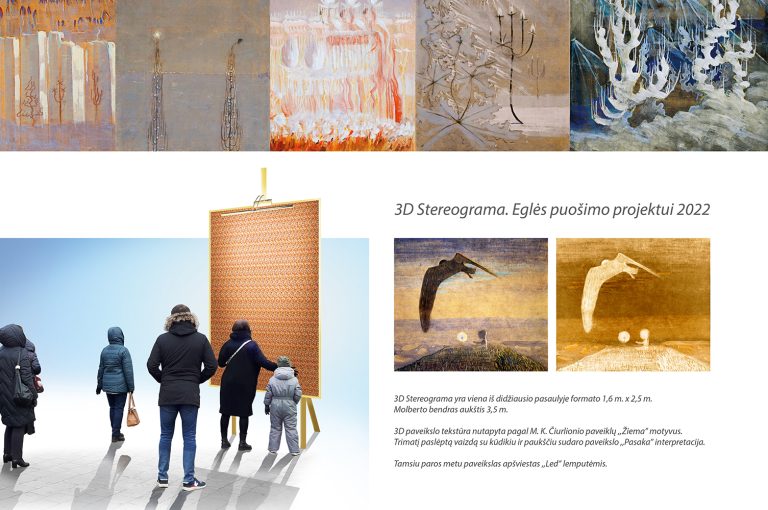Optical art – creator of stereograms, designer Loreta Roževičiūtė-Elksnė has been creating three-dimensional paintings for almost 27 years, and last year she started collaborating with the doctors of the “Mūsų akys” clinic. Doctors were encouraged to establish this partnership by the positive effects of stereograms on vision.
About the art created by “Vėjo rožė”
L. Roževičiūtė-Elksnė founded the creative group “Vėjo rožė” and, together with her colleagues, actively organizes stereogram events: lectures and education for children, participates in Kaunas City Municipality projects. Creates entertaining exhibitions and rents them out. This is a rather rare phenomenon in Lithuania, but it is a common practice abroad. The optical works of “Vėjo rožė” are purchased not only by Lithuanians, but also by optical art museums abroad.
Currently, the team is actively working on the 3D painting, which is being created according to the patterns of paintings by M. K. Čiurlionis. The idea to create a stereogram based on Čiurlionis’s work was proposed by Jolanta Šmidtienė, an artist of Kaunas Christmas trees. This time, the stereogram is created even 2.5 m high! “I was fascinated by this topic because we are fans of Čiurlionis. I hope that in the spring the painting will already be able to be seen in the M. K. Čiurlionis Museum in Kaunas and will surprise visitors with the size of the stereogram on a global scale”, says L. Roževičiūtė-Elksnė. “We have developed our own technological sequence, which is mainly manual, and extremely thorough. You immerse yourself in the depth of the picture and you don’t want to leave it” (laughs).
According to the author of the works, stereograms have an extremely high emotional impact on both herself and her team and exhibition visitors. When something starts to rise from a flat pattern and finally, we see a bright and clearly perceived hidden three-dimensional object, most people are surprised, how can this be? Where does an object that is not visible at the beginning come from? How are such paintings created?
How stereograms are created
“We can easily see the raised pattern when we just look into the distance through the picture and nothing else. It is really very simple and much easier than you can imagine. No need to squint or roll your eyes. Just watching us look out the window. Then the eyes themselves “catch” the hidden object, Loreta explains. – First the pattern is drawn, then I “edit” the pattern on the computer. This is also me, when I want to bring up a drawing, I mainly look at the distance and put the pieces of the drawing in a very precise sequence. Depending on the different spacing of the pattern, the inner pattern indents or protrudes. And if I make a mistake and don’t notice it quickly, it’s find the end of the thread“ (laughs).
Loreta says that the emergence of “Vėjo rožė” was prompted by one unexpected event. Disappearance of spots in her grandmother’s eyes, that obstructed vision, through passive eye exercise with stereograms. The artist had once given her 3D paintings as a gift to her grandmother, and she would unconsciously look at them as they were hung near the TV screen. “Until that time, creating the stereograms was my hobby, after this event it became my main activity, says L. Roževičiūtė-Elksnė. – I am glad that thanks to our medical partners, today we can talk about stereograms not only as a rare, I would say, niche field of art, but also about their benefits for the eyes.”
Ophthalmologist Kristina Kruopaitė-Brazienė, an eye doctor at the “Mūsų akys” clinic, has many years of experience in applying stereograms for preventive eye exercises. The doctor is a volunteer in the charity and support fund project “Angelo akys”, advises the project implementers on the prevention of children’s eye exercises. The foundation’s mission is to teach and encourage children to protect their vision, providing them with targeted knowledge and forming the necessary skills.
When did you first encounter stereograms?
My classmate’s mother was an actress, we used to go to the Juozas Miltinis Drama Theatre located in Panevėžys, there was a magical book-atlas where you could see the most amazing images. This was my first introduction to stereograms. I didn’t know then what a magical book it was.
Why is this book magical?
It wasn’t until many years later that I realized how that book had helped me myself, and later received confirmation from my patients. During my studies, during one of the events, I found out that I am hypermetropic (hypermetropia is a refraction defect when the light rays in the eye intersect behind the retina. This is usually due to short-sightedness. It is corrected with plus lenses). And not just farsightedness (hypermetropia), but to a greater degree, because the doctor who diagnosed me with hypermetropia was very surprised why I was without glasses, and he wondered how I see. At the time I thought it was just a misdiagnosis because I could always see well. I had my refraction checked regularly and it kept confirming that I was hypermetropic.
Do you remember any patient stories related to stereograms?
Once, on the same day, two men, 10 years apart, came in for worsening near vision. Both men did not wear glasses until then. Men were prescribed exactly the same reading glasses (SPH +1.0D). I recommend everyone to exercise their eyes as a preventive measure, one of the ways to exercise is to use stereograms. It turned out that the older man actually had an atlas with stereograms at home, which he often looked at. It helped him that reading glasses were designed later and with smaller dioptres.
Another memorable case is a mother with her daughter. Her daughter (age 10) was given glasses for distance vision. And the mother said that she started wearing distance glasses only after giving birth and that they were quite weak. At the mention of stereograms, the mother recalled that she had played with a stereogram atlas throughout her childhood.
Can all people see stereograms?
Too bad, but not everyone. There are diseases due to which a person loses the ability to see stereo images, although he had such an opportunity before. These include glaucoma of a higher degree, loss of one eye, damage to the yellow spot (macular), neurological diseases, etc.
Stereopairs / stereograms work because the brain can detect small differences between the images seen by each eye.
Anatomically, three levels of binocular vision are required to see stereo images: 1. simultaneous perception; 2. fusion (binocular “one” vision); 3. stereopsis.
These functions develop in early childhood. Some people with strabismus have trouble developing stereopsis, but orthoptic treatment can be used to improve binocular vision. A person’s stereoscopicity determines the smallest difference in an image that he can perceive as depth. It is believed that approximately 12 percent patients cannot see 3D images properly due to various medical conditions. Some patients have very weak stereoscopic vision, preventing them from perceiving depth according to stereodiscretion. This eliminates or greatly reduces the depth effect of stereo images.
How can the use of stereograms help a person improve their vision?
First, we should talk about how stereograms work. Stereoscopy creates the illusion of three-dimensional depth from a pair of two-dimensional images. Human vision, including depth perception, is a complex process that begins only with the acquisition of visual information received through the eyes; the brain performs many processing processes as it tries to make sense of raw information. One of the functions of the brain in interpreting what the eyes see is to estimate the relative distance of objects from the viewer and the depth of those objects.
Generally speaking, in order to see a stereo image, we use the eye muscles to help, the eyes start to accommodate more actively. Accommodation is the ability of the eye to change its refractive power in such a way that it can clearly see objects at different distances. The degree of accommodation depends on the distance of the object. During accommodation, the oculomotor muscle contracts, the ligaments holding the lens relax, it bulges and its refractive power increases.
Clinic “Mūsų akys”
Nepriklausomybės a. 31A, Rokiškis
Nemuno g. 79-6, Panevėžys
www.musuakys.lt
Source: magazine “Raktas” No. 02 (195) – February 2023, prepared by Agota Džiugaitė, www.raktas.eu




